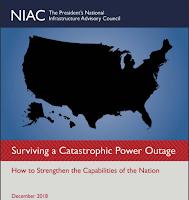
#15,823
I come by my penchant for preparedness honestly, beginning in my youth as part of the Scouting program, to my years working as an EMT and then a Paramedic, to nearly 15 years spent living and cruising aboard boats in Florida, and to a decade living on 25 wooded acres in the backwoods of Missouri.
Most of what I know today, I learned from making mistakes along the way. But occasionally, I found myself better prepared than I might have been, and that has sometimes made a sizable difference in the outcome.
Being prepared for an emergency doesn't guarantee you and your loved ones will come out unscathed. But it does improve your chances.
The full impact - both in terms of lives lost, and damage - from this past week's winter storm in Texas, Louisiana, and Oklahoma won't be known for weeks, or even months. And while we like to say its a `once in a century' event, the truth is, one or more regional disasters of this magnitude occur somewhere in this country every year.
And as our national infrastructure ages (see ASCE report card on America’s infrastructure), and our dependence upon the continual flow of electricity and information increases, we may find these sorts of prolonged power/water/comms outages may become more common.
While natural disasters (earthquakes, hurricanes, winter storms, etc.) are the most likely threat, there are bad actors capable of wreaking havoc with cyber or other attacks on our power grid, water, supply, and communications systems.
In December of 2018, in NIAC: Surviving A Catastrophic Power Outage, we looked at a NIAC (National Infrastructure Advisory Council) 94-page report that examined the United State's current ability (or lack, thereof) to respond to and recover from a widespread catastrophic power outage.
What is a catastrophic power outage?
• Events beyond modern experience that exhaust or exceed mutual aid capabilities
• Likely to be no-notice or limited-notice events that could be complicated by a cyber-physical attack
• Long duration, lasting several weeks to months due to physical infrastructure damage
• Affects a broad geographic area, covering multiple states or regions and affecting tens of millions of people
• Causes severe cascading impacts that force critical sectors—drinking water and wastewater systems, communications, transportation, healthcare, and financial services—to operate in a degraded state
In 2015, well known journalist Ted Koppel published a book called Lights Out: A Cyberattack, A Nation Unprepared, Surviving the Aftermath, that explored our vulnerability to a deliberate cyber attack.
Perhaps the most worrisome is a `Carrington-class' Solar storm, that in a worst case scenario could conceivably leave large swaths of the world in the dark for months or even years. .According to NASA, we actually came very close to seeing it happen in 2012 (see NASA: The Solar Super Storm Of 2012). You'll find a report, and a 4 minute video from NASA explaining earth's close call below, then I'll return with more.
Near Miss: The Solar Superstorm of July 2012Such events were once thought to occur only once every few hundred years,but scientists have discovered that these severe solar storms happen far more often (See Destructive Solar Storms Usually Hit Earth Every 25 Years or So, Say Scientists).
While we are understandably focused on dealing with COVID-19 right now, we can't afford to wait until this pandemic has passed, and our economy has recovered, before we prepare for the next crisis.
Spring tornado season is just around the corner, the 2021 Atlantic Hurricane season is but 100 days away, and earthquakes can happen anytime, and without warning.
And since we can't know exactly what threats we will face, we need to work on improving individual, family, community, and governmental All Hazards preparedness.
In 2013, the CDC produced the All-Hazards Preparedness Guide and their Emergency Response and Preparedness website provides tools for the whole community (e.g., individuals, families, communities, businesses, and jurisdictions) to use in order to prepare for a wide range of disasters.
My hope is that in 2021 we can promote a newfound culture of preparedness - not only in this country - but around the world. If we don't, we run the very real risk of being caught flat footed once again, and the next time could be substantially worse than what we are dealing with today.
So . . . if a disaster struck your region today, and the power went out, stores closed their doors, and water stopped flowing from your kitchen tap for the next 7 to 14 days . . . do you already have:
- A battery operated NWS Emergency Radio to find out what was going on, and to get vital instructions from emergency officials
- A decent first-aid kit, so that you can treat injuries
- Enough non-perishable food and water on hand to feed and hydrate your family (including pets) for the duration
- A way to provide light when the grid is down.
- A way to cook safely without electricity
- A way to purify or filter water
- A way to stay cool (fans) or warm when the power is out.
- A small supply of cash to use in case credit/debit machines are not working
- An emergency plan, including meeting places, emergency out-of-state contact numbers, a disaster buddy, and in case you must evacuate, a bug-out bag
- Spare supply of essential prescription medicines that you or your family may need
- A way to entertain yourself, or your kids, during a prolonged blackout
If your answer is `no’, you have some work to do. A good place to get started is by visiting Ready.gov.
And for some of my past preparedness blogs, you may wish to revisit:
